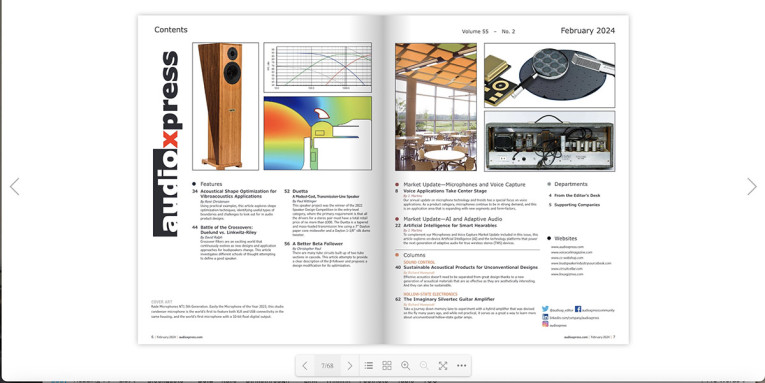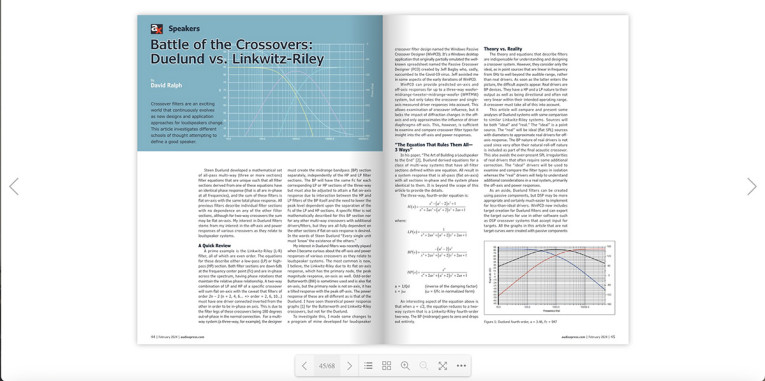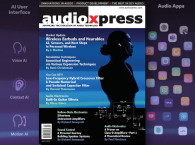 The February 2024 issue of audioXpress offers the latest Market Update on Microphones and Voice Capture where we highlight all the most important products, from MEMS to large diaphragm studio microphones. As the title indicates, our annual update on microphone technology and trends has a special focus on voice applications this year. As a product category, microphones continue to be in strong demand, and this is an application area that is expanding with new segments and form-factors. audioXpress recaps everything interesting in this fascinating and strategic market segment, always at the front end for innovative applications in voice recognition, transcription, and processing.
The February 2024 issue of audioXpress offers the latest Market Update on Microphones and Voice Capture where we highlight all the most important products, from MEMS to large diaphragm studio microphones. As the title indicates, our annual update on microphone technology and trends has a special focus on voice applications this year. As a product category, microphones continue to be in strong demand, and this is an application area that is expanding with new segments and form-factors. audioXpress recaps everything interesting in this fascinating and strategic market segment, always at the front end for innovative applications in voice recognition, transcription, and processing.And to follow up on this microphone and voice feature, there needed to also be an update related to product development regarding voice and AI applications. That is why this February 2024 issue features a second Market Update on AI, Adaptive Audio Enhancement, and Noise Cancellation. Titled "Artificial Intelligence for Smart Hearables," the report anticipates a lot of the solutions and key technologies presented at CES 2024. Those are strongly focused on edge AI (on-device) and platforms that power the next-generation of adaptive audio for true wireless stereo (TWS) devices.

Returning this month with a Simulation Techniques article, René Christensen writes about "Acoustical Shape Optimization for Vibroacoustics Applications." After having explored how formal optimization can be used for product design of audio products such as speakerphones and waveguides, Christensen explores free-form and alternative optimization techniques where the topology of the geometry is given from the outset. Using practical examples, this article explores shape optimization techniques, identifying useful types of boundaries and challenges to look out for audio product designs.
In this month's Sound Control column by Richard Honeycutt, the topic is "Sustainable Acoustical Products for Unconventional Designs." An interesting overview of various suppliers serves to show that effective acoustics doesn't need to be separated from great design, thanks to a new generation of acoustical materials that are as effective as they are aesthetically pleasing. And they can also be sustainable.
Transitioning to speaker design, David Ralph offers an interesting article called "Battle of the Crossovers: Duelund vs. Linkwitz-Riley," in which he investigates different schools of thought attempting to define a good speaker. Crossover filters are an exciting world that continuously evolves as new designs and application approaches for loudspeakers also change. A few schools of thought have created interesting approaches in approaching phase and frequency response, as well as off-axis and power responses.

And for an actual DIY speaker project, this issue features an interesting design by Paul Kittinger, which was the winner of the Parts Express 2022 Speaker Design Competition in the entry-level category, where the primary requirement was that all the drivers for a stereo pair must have a total retail price of no more than $300. The Duetta is a modest-cost tapered and mass-loaded transmission line using a 7" Dayton paper cone midwoofer and a Dayton 1-1/8" silk dome tweeter. In Italian, the word Duetto, close to duetta, means a musical piece for two instruments or singers - and this pair is certain to delight any builders.
Transitioning to Audio Electronics, Cristopher Paul returns to the pages of audioXpress with "A Better Beta Follower." As he wrote in his introduction, there are many tube circuits built up of two tube sections in cascode, variously known by the acronyms SRPP, a-SRPP, u-follower, WCF, β-follower, and more. Two main properties set apart these circuits: one, they all look deceptively simple; and two, very few descriptions of the circuits get it right. In this article, Cristopher Paul offers a clear description of the β-follower and optimization of the circuit for specific parameters.
Finally, in Hollow-State Electronics, Richard Honeycutt takes us on a journey down memory lane to experiment with a hybrid amplifier that was devised on the fly many years ago - an Imaginary Silvertec Guitar Amplifier. The experiment consists of replacing the original power stage of his beloved Silvertone Model 1484 Twin Twelve guitar amp and replacing it with an Altec a-340a power amp. The results required some adjustments but inspired the circuit that we can now simulate with an LTSpice model. A great way to learn more about unconventional hollow-state guitar amps.

As always, we would like to gently remind you to renew your subscription for 2024. All the content contained in every issue of audioXpress is the reason why, month after month, 12 times per year, this publication continues to reinforce its role as an essential resource for the audio industry. Your support and that of our advertisers is what allows us to keep this publication in print and all digital platforms and pay our independent authors and contributors for their work.
Subscribe if you haven't done so yet in order not to miss future issues or renew your subscription. Subscribing to the digital online version allows immediate access and is available here: audioXpress Subscription Services
If you wish to buy a single printed issue or the complete audioXpress archive on USB, from 2000 to 2024 (yes, including the latest issue), just visit our online shop at www.cc-webshop.com
Don't miss out, get your copy of audioXpress right now at www.gotomyxpress.com






